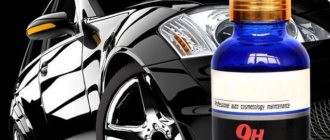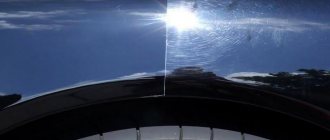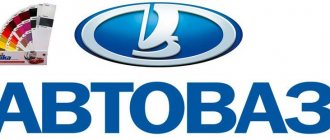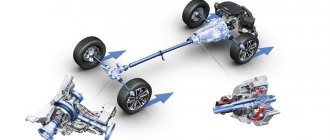The car should please the owner, but over time or due to some negligence the protective layer weakens, the car rusts, stains, scratches, and cracks appear. The protective layer needs our constant support. And the best assistant in this is liquid glass (LC) for cars.
To understand its importance, in order to keep the car in excellent condition for a long time, you must first know the components of the car, its capabilities, how to use it correctly, what to choose from what the market offers, what the price range is.
What is liquid glass
Liquid glass for cars has been sold in the Russian Federation since the second half of the 2000s. and is actively used in car washes and by private car owners to improve the appearance of vehicles and protect against negative influences. Despite the name, the product has nothing in common with real glass, but only creates the effect of its presence on the surface of the car. The product is used all over the world. For example, in Japan such polishes are called Glass Coat, which is translated into Russian as “glass coating”.
Body treatment with liquid glass - the rear is treated, the front is not
To understand why a car body should be treated, let’s consider the properties of liquid glass. This is an additional coating applied to the surface of the car, which completely protects the metal and paintwork from contact with the outside world. The composition isolates the body from:
- moisture;
- road reagents containing salts;
- sandblast flying out from under the wheels;
- ultraviolet rays;
- mechanical damage (scratches from branches, chips from stones flying at low speed, etc.).
At the same time, treating a car with liquid glass leaves the outer layer completely transparent, so the color of the paintwork, stickers and airbrushing are clearly visible.
Liquid glass for cars also creates a lens effect, making the color of the paintwork deeper and more voluminous. Due to its thickness and gloss, the coating transforms the appearance of the car, making it shine.
On the body you can see reflections of the sun, lanterns, and light from the windows of houses. The glow shimmers, and the car looks as if it came straight from the showroom after purchase.
Which liquid glass manufacturer to choose
Almost all manufacturers today produce decent products. Therefore, be guided only by your own preferences. But at the same time:
- do not neglect to study the composition - it must contain sodium or potassium;
- pay attention to the price - do not consider too expensive or cheap formulations;
- open the container and visually evaluate the product - potassium ones have a marshy tint and increased viscosity, but sodium ones are liquid in a gray tone.
Important! User reviews will help you get the most complete information about ceramics on your car. Special auto forums contain comments from those who have already tried products from different brands and formed their own opinion about them.
Types of liquid glass
Although such auto chemicals have the same purpose, liquid glass differs in packaging methods and base. In Russia there are three types based on key components:
- Lithium - contains lithium, is produced in small quantities and has thermoregulating properties. One of the rather rare coating options.
- Sodium - is made on the basis of sodium and protects the car body well from elevated temperatures.
- Potassium - contains potassium, has a loose structure with increased porosity and effectively absorbs water.
All of the above types belong to mono-alkaline compounds. Manufacturers can combine them with each other, producing complex polishes with special additives that improve the effect of application on the car. In their normal state, these compounds are liquid, but upon contact with air they begin to dry out and form a protective film. It is so hard that it can withstand impacts from branches and rocks, keeping your car looking new.
Liquid glass application kit
Possible additives may include:
- Silicon dioxide - contributes to the mechanical strength of the protective coating.
- Decamethylcyclopentasiloxane - to prevent oxidation of the body metal.
- Titanium oxide - promotes whitening of the body and protects against the negative effects of high temperatures.
- Surfactant is an abbreviation that stands for “surfactants”. They are added to most of these products and ensure that dirt is removed from the surface of the car, maintaining a clean body.
- Aluminum oxide is responsible for fire-resistant properties.
Liquid glass for cars is presented on the Russian market in two form factors: liquid and paste. In the first case, these are containers with a volume of 100-200 ml, equipped with a sprayer. The composition is already ready for application - you unlock the spout and treat the entire surface of the car, then wait for it to dry. The second option is pastes in tubes of about 50-100 ml. They can be ready for use or supplied with a hardener that needs to be added to the base composition and mixed. The coating also comes in light and dark colors.
Popular brands:
Kia Sportage, Nissan Qashqai, Renault Duster
Liquid glass for cars: disadvantages and advantages
If you are thinking about switching to using this polish, then first of all you need to analyze the advantages and, of course, disadvantages of liquid glass for cars. Let's start with its good qualities:
- The product allows you to protect your vehicle from many damages caused by chemical and mechanical influences, high temperatures, and adverse weather conditions.
- Glass restores the appearance of the car, correcting existing flaws.
- Car coverage needs to be renewed quite rarely: no more than once a year.
- Liquid glass does not distort the original color of the body due to its transparency.
- Allows you to achieve a perfectly smooth surface that will not get dirty even in the rain and when driving on dirty roads.
- With a sharp increase in temperature, the polish does not lose its properties and appearance.
- Glass protects the car from sunlight, thereby maintaining the depth of color of the paint layer.
- Statistical charges are not stored on the machine.
- The silicon dioxide in the composition gives additional strength to the body.
Despite all the advantages, there are also disadvantages of liquid glass for cars, but their number is insignificant:
- Liquid glass will not be able to protect the body at extremely low temperatures.
- The coating will last less if you use detergents when washing the car. It is better to get by with plain water and a soft sponge.
- If your car has been serving you for many years and you decide to cover it with liquid glass, then the body must be carefully prepared before this procedure.
Advantages and disadvantages
Having considered the composition and types of protective polish, we will summarize the positive and negative aspects of applying liquid glass to the surface of a car. The advantages include the following:
- Protects metal from rust.
- Creates a mirror effect on the surface, like new cars.
- The paint does not fade under the influence of ultraviolet radiation.
- The color of the paintwork becomes deeper.
- Repels water and dirt from the surface, so you have to wash your car less often and it always looks clean.
- The coating eliminates (masks) not deep scratches.
- Promotes an antistatic effect - dust does not stick to the body.
- Reasonable price if you apply it yourself.
- Effects from 6 to 12 months are possible.
Liquid glass coating test for dirty water
But liquid glass treatment cannot work a miracle on a surface that is heavily scratched, chipped or frosted. Such defects will be visible even after coating. In the case of processing in a professional service, and not with your own hands, the price for the work exceeds the cost of the composition several times. Liquid glass can only be applied to a car at above-zero temperatures, so in winter it will not be possible to use it without a heated room. The service life of the coating depends on the manufacturer: for some, the effect disappears after 10-12 washes, so you need to study many forums and reviews to choose the right option.
Why apply liquid glass to your car?
A new car, coming off the assembly line, has a perfect shiny glossy surface and a beautiful bright color. He is aesthetically very beautiful and attractive. Over time, during use, the car imperceptibly loses its shine and beauty. Its surface is covered with small scratches, chips, cracks, and abrasions. And outwardly it begins to be significantly inferior to the new car.
For some, this doesn’t matter at all: the main thing is that the car drives. For others, the appearance of the car is very important and emphasizes the status and success of the owner. And some people just want to own a beautiful car. In this case, there is a way to return the car to its original appearance and former beauty - liquid glass.
Wax-based polishes do a good job of this function, but their effect is short-lived and the polishing procedure must be repeated again and again. Modern polishes - liquid glass - allow you to achieve the desired effect for a much longer period.
In addition to polishing the body, liquid glass can be applied to headlights; it restores the smooth structure of the glass, removes haze and scratches and makes the light from the headlights brighter.
Applying liquid glass to the surface of the car allows you to wash the car less often, since the paintwork becomes less susceptible to dirt; dirt particles simply do not linger on the car, but bounce off it. If the car gets caught in the rain, there are no smudges left on the surface from drops, which means you don’t have to wash the car after every rain.
The strength of liquid glass applied to the surface of a car depends on its initial condition and the preparation carried out.
The effectiveness of liquid glass coating depends on:
- the newer the car, the stronger the effect will be: a new car has industrial varnish, so the final result will be the most durable and hard;
- if the car has been repainted, then the strength of the liquid glass will be less, since the varnishes used in the repair are much “softer” than the factory ones;
- If the machine has repainted parts, and moreover, if the paint was applied at different times, then for a good result such a machine will require more thorough preparation and grinding before applying liquid glass.
You should not expect that after applying liquid glass the saturation, brightness and depth of the color of the car will increase. The color will remain the same, and such a statement is nothing more than a crude marketing ploy.
A car treated with liquid glass does not require as frequent washing as a regular car. After long trips, it is enough to rinse the car with clean water without detergents to remove dust. And the shiny surface instantly restores its appearance.
Liquid glass coating technology
Application of liquid glass must be carried out in accordance with the instructions and according to the technology established by the manufacturer. Only then can you be sure of a quality result. Surface treatment is allowed at ambient temperatures of +10…+40 degrees.
Note! If the car has just been driven from the street into the box in the summer, the metal of the body can be heated to 70 degrees and needs to be allowed to cool. Even in winter, the hood, in the area above the engine, can get very hot, so you should wait 10-15 minutes.
The application procedure is carried out in a garage or hangar, without direct sunlight. It is important that the room is well lit for better visibility of the surface and evaluation of the result. Application is allowed on all body parts, including plastic bumpers, chrome elements, and headlights. The exception is the windshield, side and rear glass, and the reflective part of the mirrors. The action takes place on a dust-free surface. It is important that no wind blows into the box, otherwise dust particles may stick to the top and ruin the coating.
The application procedure is carried out in a box
The application technology involves sequential coating of body elements, followed by rubbing, drying and polishing the surface. You cannot treat the entire body at once, since the polish will dry quickly and you will not have time to rub it properly. The action starts from the roof, then you can move on to the hood, trunk, doors, fenders, bumpers.
Advice! At the very beginning, apply polish to a small area of the body (for example, on the corner of the rear bumper), rub it, wait until it dries and polish. This will help you see how the body color will play and decide whether the composition is suitable for your car.
Materials and tools
To properly coat a car with liquid glass, you need to stock up on all the necessary tools and materials in advance. For this you will need:
- sponge and brush for pre-washing the body;
- car shampoo;
- a towel for wiping the surface dry;
- clay for cleaning the body from bitumen stains and other inclusions;
- degreaser;
- the polish itself and microfiber (often supplied in the kit).
If a spray polish is selected, a manual spray attachment is usually sold together. For formulations in bottles, direct application to rags is also acceptable, so no other equipment is required. If a two-component product (with a hardener) is used, prepare a container for mixing and a spatula or spoon for manipulation.
Surface preparation
Protecting a car with liquid glass requires proper preparation of the body surface, otherwise the composition simply will not stick properly or dirt will be visible through it. First, the car is washed with foam, for which car shampoo is used. The body is cleaned with a brush or large sponge. Then the foam is washed off with clean water and the surface is wiped with a towel.
First, the car body is washed well
On any body there are inclusions of bitumen, bird droppings and other points that must be removed, otherwise they will be visible through the glass coating. For this, blue clay is used, which acts as a scrub. Spraying plain water onto the surface, make circular movements. Clay sticks to itself all foreign particles and dust residues.
After this, a degreaser is used, which finally prepares the surface for processing. Use any car degreaser sold at your local auto store. Let the car dry.
Do-it-yourself application of liquid glass on a car: instructions
The procedure for treating a car with liquid glass with your own hands is simple. Let's look at this using the example of a polish in a bottle without a sprayer:
- Squeeze the product onto the sponge included in the kit.
- 1/3 cap is enough to cover 0.5-0.7 m².
- Rub this thoroughly but quickly over the surface.
- Make sure there are no gaps on the body. To do this, look at the car from different angles.
- Give the composition time to harden. Depending on the manufacturer and type of product, this takes from 30 seconds to 3 minutes.
Rubbing liquid glass with your hands
After this, they begin polishing and move on to the next area. If you immediately apply the coating to the entire surface of the car, it will appear as a white, dried coating. You won’t have time to polish it later, and the layer will have to be removed mechanically, pressing hard on the surface. Therefore, the action is performed in sections so as to grind the substance at a time, without moving along the body. When using compounds in bottles with sprayers, everything happens in the same sequence, only you can spray it onto the body directly from the container, and not onto a sponge.
The process of coating a car body with liquid glass
In order for the process of applying liquid glass to a car body to be enjoyable and, most importantly, to ensure a long-lasting result, it is necessary to follow a certain sequence of actions. Here are some basic stages of applying liquid glass to a vehicle.
Required materials and tools
Before you start work, you need to prepare the necessary materials and tools. The following tools should be included with a standard polish.
- Basic composition.
- Hardener.
- Mixing pipette.
- Fiber for manual polishing.
- Towels.
- Sponges.
- Gloves.
If any of the above is missing from the composition, it must be purchased in addition.
Preparing the car body
It is imperative to prepare the surface of the car. This is one of the important stages in the polishing process and should not be skipped! Preparation consists of the sequence of the following actions.
- The vehicle is thoroughly washed and all dirt is removed.
- The surface is degreased using white spirit, previously diluted in water.
- The car is given time to dry.
It is strictly forbidden to use mixtures containing silicone or low-quality alcohol for degreasing.
Another important rule is to remove the previous polish. Neglecting this advice will result in the new layer of liquid glass remaining on the surface much less than the period guaranteed by the manufacturer.
It is equally important in the preparation process to select a site for work. Preference should be given to a dry, ideally ventilated place, where the temperature ranges from 15 to 40 °C above zero. The best option would be to perform polishing in the garage, or outside, but always under a special canopy.
When applying the composition, the body should not be exposed to sunlight, dirt and dust.
Coating a car body
Once the preparatory work is completed, you can begin the process of polishing the car. If you don’t have experience, you don’t need to immediately apply the entire composition to the entire surface of the body; it is advisable to practice a little on a small area. If, after testing, the polish adheres well to the surface, if the desired result is achieved, then you can begin the work process.
Liquid glass is applied gradually; it is important to carefully process area by area. Many professionals advise starting with the bumper or the right fender. After finishing processing one part, you can move on to the next step, rubbing the surface with a soft cloth, which is usually included in the kit. This approach will allow you to perform the work more efficiently, as well as avoid drying of the applied coating, which is convenient if it is necessary to correct certain defects.
This is interesting: What is the ERA-GLONASS system and how does it work? Functions, installation and 2 operating modes
Once the entire body of the vehicle has been processed, you need to leave the car alone for 4 - 6 hours. Only after this can you begin to move the car, but without visiting car washes, since the final setting of the composition occurs after about 14 days. Only after two weeks the vehicle body is completely protected from ultraviolet radiation, mechanical influences and other unpleasant factors.
Options for accelerating polishing
On average, covering a car with liquid glass takes about 5 - 6 hours, and if this is the first time, then even longer. This is a rather labor-intensive process that not everyone can handle. As you gain experience, the task can be simplified by using a special grinding machine. You will need to purchase this equipment, select a special soft pad for polishing and set the device to a medium speed mode.
Professional opinion! During the processing process, you do not need to press hard on the grinding device. This will avoid completely unnecessary overheating of the surface.
If there is no opportunity or desire to get a professional grinding machine at your disposal, an elementary electric drill, which is at the disposal of every man, is suitable as an optimal alternative. The main thing is just to choose an attachment for it to firmly fix the polishing wheels.
If everything is done correctly, you can enjoy the body of your car throughout the year. It will need to be updated approximately once a year. Once the coating has completely set, you can visit a car wash or clean the vehicle with a bottle of water and a clean rag.
Polishing
After applying the glass coating, it is important to polish it quickly. To do this, use microfiber (yellow or blue), supplied in the kit. The action is performed in a circular motion, sequentially passing through the treated area. You need to rub until the effect of deep paintwork color without whitish streaks appears.
Important! When applying, you don’t need too much of the compound, since the paintwork will stick to itself a thin layer, and the rest will have to be cleaned off during polishing.
Since bodywork is carried out in segments, pay attention to the boundaries of the sections. There may be stains on them. Rub such areas thoroughly with microfiber. To speed up and facilitate the process, you can use a microfiber attachment on a grinder, drill or polishing machine.
Polishing applied liquid glass with a machine
Are there any special features for car care after the procedure?
Treating a car with liquid glass requires compliance with certain rules:
- Do not drive the car for 6 hours so that the coating completely hardens and dust does not stick to it.
- The car is not washed for the next two weeks - this is necessary for polymerization and hardening of the outer layer.
- Subsequently, only touchless washing is allowed.
- Do not use abrasive cleaning agents.
- In winter, it is forbidden to use a scraper to remove snow from the surface of the vehicle—only a brush.
Stages of liquid glass processing
The car polishing process consists of several stages:
- complete car wash with removal of complex contaminants from the body (bitumen, insects);
- degreasing the entire surface of the body with special solutions;
- polishing using professional polishing pastes;
- car detailing from bumper to bumper, including headlights, glazing and chrome body elements;
- application and polishing with liquid glass in several layers (from 3 to 10);
- final drying of the applied coating.
It should be remembered that after this procedure it is necessary to avoid washing the car for two weeks. This requirement is due to the fact that over the specified time the coating acquires the properties and hardness necessary for protection and shine.
As you can see, polishing a car with liquid glass is a labor-intensive and lengthy process, taking from one to two days of work.
Reviews from car owners
I applied liquid glass to my car in the summer. The color has become very deep and rich, from the outside the car looks like new, although it is more than 10 years old. Dust actually sticks less, so I save on washing. Yuri, Chevrolet Aveo
After application, the car looks clean, there are no streaks left from the rain, the drops simply roll off without stopping. I rubbed it by hand, the whole process took 1 hour, but my hand was very tired. If possible, use a machine for polishing. Ignat, Mitsubishi Lancer
Treatment with polish deepened the color, making it pure. The surface is mirrored and reflects luminous lights. Looks very nice. But my bumper had small chips from stone impacts (before the primer). They were invisible because they were tinted with dust. And after cleaning with clay and degreasing, they became clearly visible. Next time I want to paint the bumper first and then apply the protective coating. Oleg, Subaru Forester










